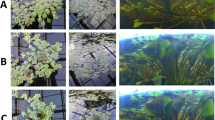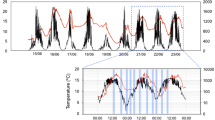Summary
-
1
Two species of plants (Taraxacum arcticum and Arnica angustifolia), collected in Spitsbergen (geogr. latitude 76–80 degrees) exhibit endogenous circadian leaf movements but also movements with shorter periods. Astragalus frigidus, A. alpinus and Hedysarum hedysaroides, collected in arctic regions of continental Europe, also show endogenous diurnal leaf movements.
-
2.
In most of the species tested, there was no difference in the length of the free running periods of plants from arctic and Central-European regions. This is also the case when individuals of the same species collected in different regions are compared. However, in Taraxacum arcticum the period is shorter than in T. officinale In general, under constant conditions the circadian oscillations of arctic plants persist for a shorter period than those of other plants.
-
3.
The free running periods of several of the investigated species from tropical regions are much longer than 24 hours, i.e., much longer than those of species from Central-European and arctic regions.
-
4.
The free running periods of several tropical species are temperature-independent (Erythrina senegalensis, Albizzia lophanta, Rhynchosia memmonia, Vigna catjang, Phaseolus multiflorus). In other tropical species, however, the periods decrease rather strongly with increasing temperature (Phaseolus mungo, Canavalia obtusifolia, Clitoria ternatea, Dolichos lablab, Vigna sesquipedalis, Dolichos zebra). The temperature does not influence the amplitudes in Phaseolus mungo and Vigna sesquipedalis, but it strongly influences the amplitudes in Erythrina senegalensis, in LD-cycles as well as in continuous light.
-
5.
The arctic plant Astragalus frigidus still shows free running oscillations at 12°C, whereas several tropical species oscillate only at temperatures above 17°C.
-
6.
The differences in the periods of tropical and non-tropical species (see under [3]) disappear if the plants are compared not at the same temperature but at temperatures which are optimal for them. If tropical plants are tested 27°C and Central-European and arctic species at 17°C, the periods always approach the value of 24 hours.
Zusammenfassung
-
1.
Aus der Flora Spitzbergens (76.–80. Breitengrad) wurden für Taraxacum arcticum und Arnica angustifolia endogen-circadiane und kurzperiodische Blattbewegungen nachgewiesen. Aus dem arktischen Europa unter 70° nördlicher Breite, wurden bei Astragalus frigidus, Astragalus alpinus und Hedysarum hedysaroides endogen-circadiane Blattbewegungen gefunden.
-
2.
Der Vergleich der circadianen Rhythmik bei arktischen und mitteleuropäischen Pflanzen (auch der intraspezifische Vergleich arktischalpiner Pflanzen) ergibt, daß die artspezifischen Spontanperioden, abgesehen von Taraxacum officinale und Taraxacum arcticum, keine signifikaten Unterschiede erkennen lassen. Bei Taraxacum arcticum ist die Spontanperiode kürzer als bei Taraxacum officinale. Die in der Regel geringe Zahl der circadianen Nachschwingungen bei arktischen Pflanzen könnte ein Hinweis auf eine Schwächung des selbsterregten Systems sein.
-
3.
Mehrere tropische Arten zeigen Spontanperioden, die wesentlich länger als die der mitteleuropäischen und arktischen Pflanzen sind und weit über 24 Std liegen.
-
4.
Der Temperatureinfluß auf die circadiane Rhythmik tropischer Pflanzen ist unterschiedlich: Bei 5 Arten (Erythrina senegalensis, Albizzia lophanta, Rhynchosia memmonia, Vigna catjang und Phaseolus multiflorus) ist die Spontanperiode temperaturunabhängig. Für eine dieser Arten (Erythrina senegalensis) konnte eine starke Temperaturabhängigkeit der relativen Amplitude im LL und LD nachgewiesen werden. Bei 6 Arten (Phaseolus mungo, Canavalia obtusifolia, Clitoria ternatea, Dolichos lablab, Vigna sesquipedalis und Dolichos zebra) wird die Spontanperiode mit zunehmender Konstanttemperatur kürzer. Für zwei dieser Arten (Phaseolus mungo und Vigna sesquipedalis) konnte die Temperaturunabhängigkeit der relativen Amplitude nachgewiesen werden.
-
5.
Astragalus frigidus (arktisch) zeigt noch bei 12°C circadiane Bewegungen. Einige tropische Arten zeigen in 17°C im LL keine tagesperiodischen Blattbewegungen mehr.
-
6.
Werden die Arten bei ungefähr optimalen Temperaturen untersucht, d. h. tropische Arten bei 27°C, mitteleuropäische und arktische bei 17°C, so sind die Unterschiede in den Spontanperioden (vgl. 3) weitgehend verschwunden, alle Arten zeigen Periodenlängen, die maximal 3–4 Std von der 24stündigen Periode abweichen.
Similar content being viewed by others
Literatur
Aschoff, J. (ed.): Circadian Clocks. Amsterdam: North-Holland Publ. Co. 1965.
Ball, N. G., and I. J. Dyke: An endogenous 24-hour rhythm in the growth rate of the Avena coleoptile. J. exp. Bot. 5, 421–433 (1954).
Brinkmann, K.: Planta 1966 (im Druck).
Bünning, E.: Die Physiologische Uhr, 2. Aufl. Berlin-Göttingen-Heidelberg: Springer 1963.
Günzler, E.: Über den Verlust der endogenen Tagesrhythmik bei dem Höhlenkrebs Niphargus puteanus puteanus (Koch). Biol. Zbl. 83, 677–694 (1964).
Ketellapper, H. J.: Interaction of endogenous and environmental periods in plant growth. Plant Physiol. 35, 238–241 (1960).
Klotter, K.: General properties of oscillating systems. Cold Spr. Harb. Symp. quant. Biol. 25, 185–187 (1960)
Koller, S.: Statische Auswertungsmethoden. In: H. M. Rauen (ed.), Biochemisches Taschenbuch, Teil II, S. 959–1046. Berlin-Göttingen-Heidelberg: Springer 1964.
Remmert, H.: Über den Tagesthythmus arktischer Tiere. Z. Morph. Ökol. Tiere 55, 142–160 (1965).
Siegel, S.: Nonparametric statistics for the behavioral sciences. New York-Toronto-London: Mc Graw-Hill B. Co. 1956.
Sollberger, A.: Biological rhythm research. Amsterdam-London-New York: Elsevier Publ. Co. 1965.
Stålfelt, M. G.: Die Lichtökonomie der arktischen Pflanzen. Svensk bot. Tidskr. 19, 192–214 (1925).
Steenis, C. G. G. J. van: Die Gebirgsflora der malesischen Tropen. Endeavour 21, 183–194 (1962).
Stocker, O.: Transpiration und Wasserhaushalt in verschiedenen Klimazonen. 1. Untersuchungen an der arktischen Baumgrenze in Schwedisch Lappland. Jb. wiss. Bot. 75, 494–547 (1932).
Went, F. W.: Photo-and thermoperiodic effects in plant growth. Cold Spr. Harb. Symp. quant. Biol. 25, 221–230 (1960).
—: Ecological implications of the autonomous 24-hour rhythm in plants. Ann. N. Y. Acad. Sci. 98, 866–875 (1962)
Wilkins, M. B.: The influence of temperature and temperature-changes on biological clocks. In: J. Aschoff (ed.) Circadian Clocks, p. 146–166. Amsterdam: North-Holland Publ. Co. 1965.
Author information
Authors and Affiliations
Rights and permissions
About this article
Cite this article
Mayer, W. Besonderheiten der Circadianen Rhythmik bei Pflanzen Verschiedener Geographischer Breiten. Planta 70, 237–256 (1966). https://doi.org/10.1007/BF00396490
Received:
Issue Date:
DOI: https://doi.org/10.1007/BF00396490




